Intermarkets' Privacy Policy
Donate to Ace of Spades HQ!
aceofspadeshq at gee mail.com
Buck:
buck.throckmorton at protonmail.com
CBD:
cbd at cutjibnewsletter.com
joe mannix:
mannix2024 at proton.me
MisHum:
petmorons at gee mail.com
J.J. Sefton:
sefton at cutjibnewsletter.com
First World Problems...
Iran And Minneapolis...They Are Nothing Alike!
Sunday Morning Book Thread - 1-11-2026 ["Perfessor" Squirrel]
Daily Tech News 11 January 2026
Saturday Night Club ONT - January 10, 2026 [Double Ds]
Music Thread: Dipping Into The Archives Edition
Hobby Thread - January 10, 2026 [TRex]
Ace of Spades Pet Thread, January 10
Gardening, Home and Nature Thread, Jan 10
Jim Sunk New Dawn 2025
Jewells45 2025
Bandersnatch 2024
GnuBreed 2024
Captain Hate 2023
moon_over_vermont 2023
westminsterdogshow 2023
Ann Wilson(Empire1) 2022
Dave In Texas 2022
Jesse in D.C. 2022
OregonMuse 2022
redc1c4 2021
Tami 2021
Chavez the Hugo 2020
Ibguy 2020
Rickl 2019
Joffen 2014
maildrop62 at proton dot me
TBD
Spaced-Out Challenge: Orion The Hunter
[We Politely Request That All Off-Topic or Political Comments Be Directed to the Thread Directly Below This One, Which Will Serve Officially as the Current "Active Conversation" Thread for All Discussions Not Related To This Topic]
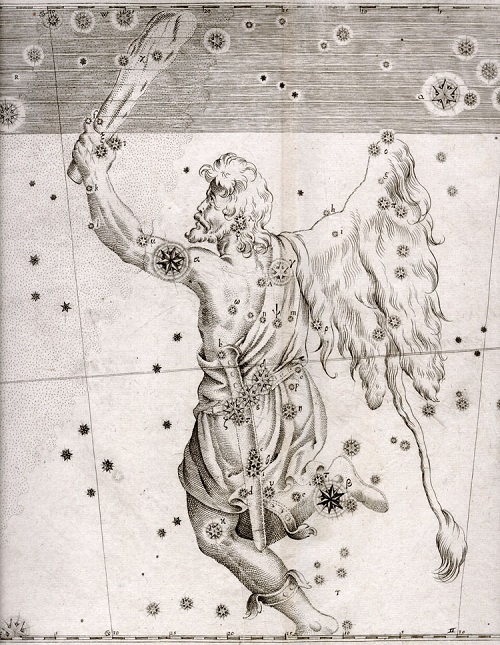
Welcome again to the Spaced-Out Challenge. Whether you have a question about a scope, a new astronomical discovery you want to expand on, or just want to kick back and enjoy the cosmos above, come one come all on our weekly journey through space and time.
This week, we kick off our comprehensive guide to the Winter sky with arguably the greatest constellation, Orion the Hunter. His seven brightest stars are resistant to the worst light pollution imaginable, and he contains too many wonders to count, but we'll try. Let me show you.
WARNING: slight blowout of margins for detailed map below.
The Myth of Orion
Dominating the nights of Winter, we get our first peak of him in late summer mornings, rising in the East only after Scorpius has set in the West. The ancient Greeks had a dramatic explanation for this seasonal alternation of great constellations, summarized best by Stoney Brook University astronomer Frederick Walker:
Orion was a skilled hunter. He was also boastful, asserting that no animal alive could harm him. Juno, wife of Jupiter, disliked mortal men, especially boastful men, so she decided to teach Orion a lesson. She placed a scorpion on the path that Orion took daily to his hunting grounds. As you might expect, Orion trod upon the scorpion, which stung and killed him. But the story does not end here, for the gods were continuously quarreling among themselves. Diana, goddess of the moon and the hunt, fancied Orion, the greatest mortal hunter. They had often hunted together at night, neglecting her lunar duties (hence the dark nights near the new moon). She insisted that his likeness be memorialized in the sky, with his hunting dogs (Canis Major and Minor) at his feet, where all could see it and remember his prowess. This did not please Juno, who insisted upon similar treatment for the Scorpion. Was it not a mightier hunter to slay the great Orion? Jupiter agreed to similarly honor the Scorpion, but in one of his wisest decisions placed the two constellations on opposite sides of the celestial sphere, where they cannot bother each other. Even today, one does not see both together in the night sky.
Frankly, Juno's full of it: Orion is the superior hunter. At least Orion tried to chase after the seven nymphs, the Pleiades, post-mortum, and Zeus had to throw a monstrous bull in the sky to blunt his appetite. Plus he has his pack of dogs. He's got a crew. Scorpius just sits there, overwhelmed by the milk of Hera's breasts, with Sagittarius' arrow trained at his heart in case he tries anything funny. But most important, Orion brings it when it comes to deep sky objects.
Navigating around The Hunter
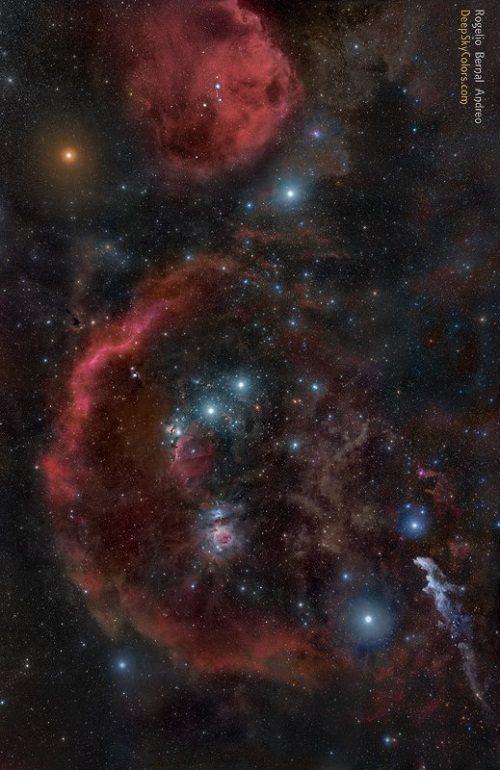
Without question, Andreo's famous photograph is unmatched in capturing the awesomeness of the treasures within this dominating constellation. The camera is thousands of times more sensitive than the human eye, yet amateur optics and filters have leveled the playing field.

The first shape that jumps out at the observer is the bright belt mid-constellation, surrounded by four bright stars north (Betelgeuse and Bellatrix) and south (Saiph and Rigel). Due south of this belt, the bright star Na'ir al Saif (Arabic for "the bright one in the sword), the Great Nebula, and it's most recent offspring form the long sword. From a dark sky site, the nebulosity, clusters, and newborn stars here stretch close to the Hunter's knees (Saiph and Rigel).
Beyond the Hunter's core, his head is marked by a triangle of slightly dimmer Meissa and a loose cluster of stars beneath; his raised arm and club can be traced from Betelgeuse up to Mu Orionis and arcing through the club shape to x1 and x2; and his shield (or, as some depict, his lion skin) stretches outward from Bellatrix.
You don't need to memorize the names or exact locations of all of these stars. But familiarizing yourself with the general shape, and referencing this chart, will put over two dozen glorious sights within easy reach.
Recommended for your journey
At minimum, a pair of binoculars will reveal several open clusters and the Great Nebula. At maximum, an amateur telescope will reveal everything listed here from a dark sky. The beauty about Orion is that it can be enjoyed from any sky: you don't have to go out into the boonies. A truly dark sky is required to reveal fainter targets like Barnard's Loop, the Meissa nebula, and the Horsehead; and will greatly enhance the views of many of the other targets listed, but just a trek to your backyard will reward you.
If you are going to go after the harder targets, visit Ace's Amazon store and purchase an H-Beta filter (I recommend a 2").
The Journey Begins: From Orion's Club to Betelgeuse
The Monkey-Face Nebula
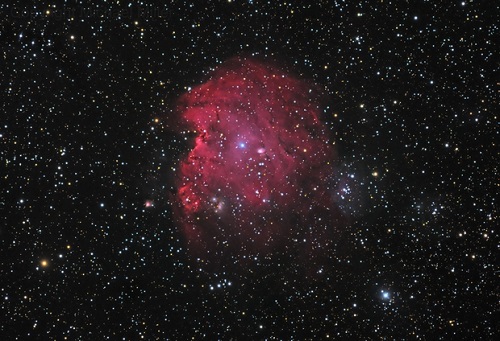
Just a degree slightly NW of x1, far up in Orion's club, lies the oddly-named but beautiful emission nebula NGC 2174. Situated in a rich field of stars, it appears about a fifth of a degree across and nearly perfectly circular. A seventh magnitude star appears to shine right in it's center, but it is superimposed. Try hunting it down with an O-III from a suburban site. It is the most interesting feature within the club.
The 37 Cluster
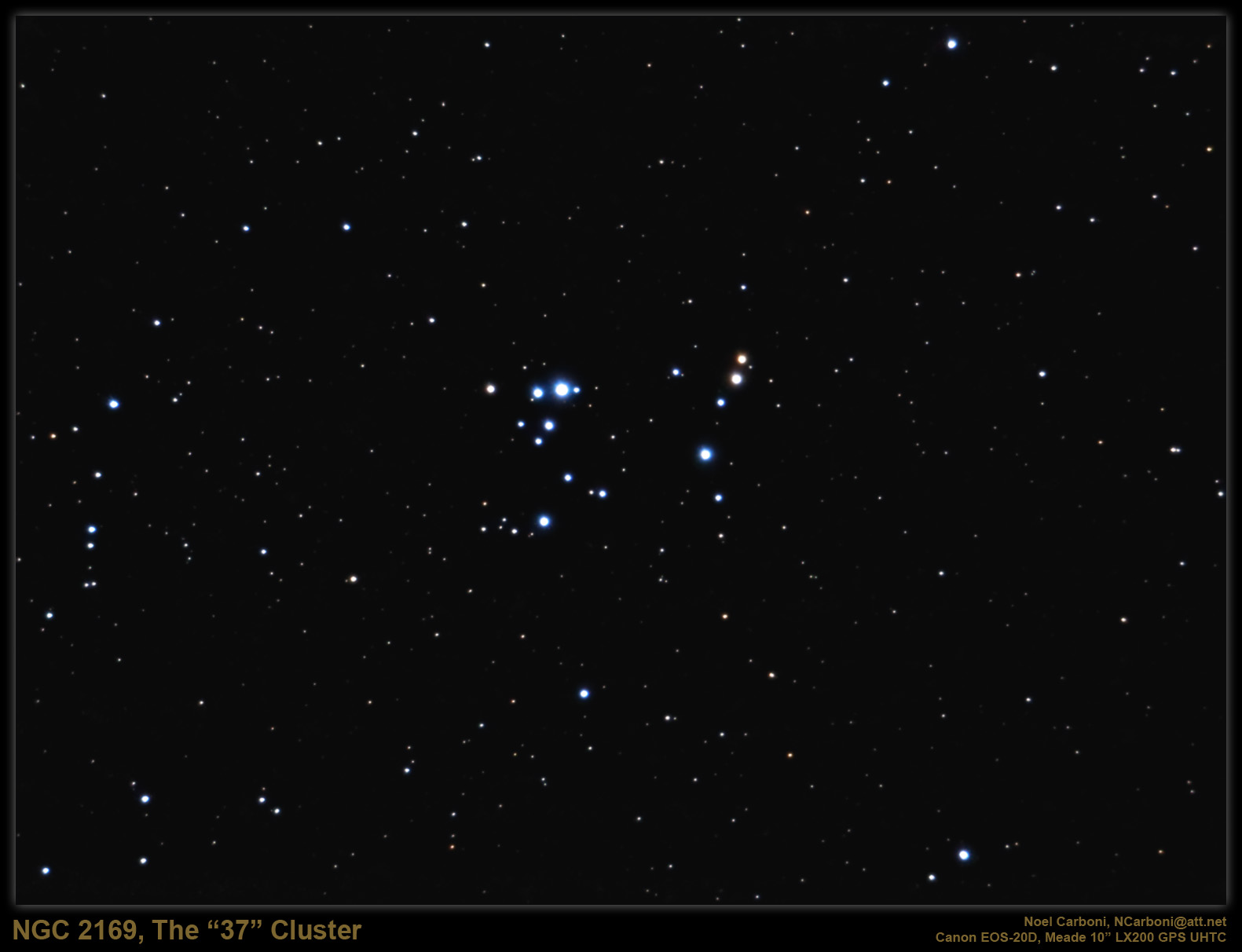
NGC2169 isn't a remarkably bright star cluster, but its shape certainly is. In either large binoculars or a small telescope, this clump of stars, visible to the naked eye as a smudge from a dark site, seems to form it's namesake. Look for it just a degree SW of Xi Orion.
Abell 12: impossibly easy and easily impossible
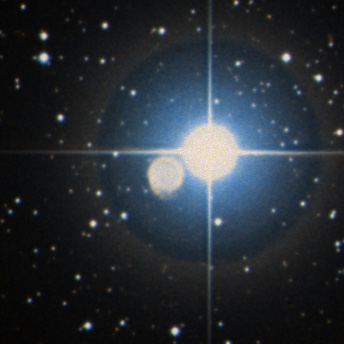
Abell 12 is frustratingly close to Mu Orionis, just 3 degrees north of the blazing supergiant Betelgeuse. However, an Oxygen III filter and medium power dims the stars and reveals the round disk of this planetary nebula. Higher power reveals some structure in the expanding dust cloud of this dead star. I'd recommend at least a telescope of 4" of aperture.
Betelgeuse: Doomed to go Boom

Incorrectly marked as the brightest star in the constellation for centuries, this bright red-orange variable is my wife's favorite, and every clear night in winter she jokes "well Betelgeuse is still there." There's a good reason for that: Betelgeuse is a red supergiant that has already exhausted it's lighter elements, and with it's incredible mass, it is racing towards supernova sometime within the next 100,000 years. Consider: while most things in the cosmos exist on a timescale utterly dwarfing our existence, many of the stars within orion have ignited, burned, and detonated within the last four million years. The bigger they are, the faster they burn, and Betelgeuse is a giant: it's outer atmosphere would envelop Jupiter if it were placed in the center of our solar system. Enjoy it while you can.
Orion's Belt: Doubles, Nebula, and and a Horsehead Bookend
The Stars of the Belt
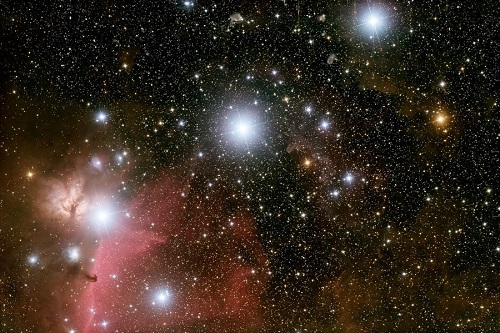
Alnitak, a brilliant double
The easternmost star in the belt, Alnitak is a challenging but rewarding double star: a bright blue primary with a close, dimmer white one.
Alnilam, a doomed one
Alnilam, the middle star, is the fourth brightest in the entire constellation, becoming the third when Betelgeuse explodes. But that title will be short lived: Alnilam is losing mass rapidly and it's internal supply of hydrogen is running low. Within a million years or less, it will balloon into a red supergiant, far brighter than Betelgeuse is now, and detonate in a supernova. Many of the stars of Orion shine brightly but at a great cost: they live fast, and die young.
Mintaka, another brilliant double
The closest bright star to the celestial equator, it rises and sets near exactly east and west. Mintaka is a multiple star system, the two brightest members of which can be split easily in a small telescope, revealing a bright white main star and a fainter blue component, the inverse of Alnitak.
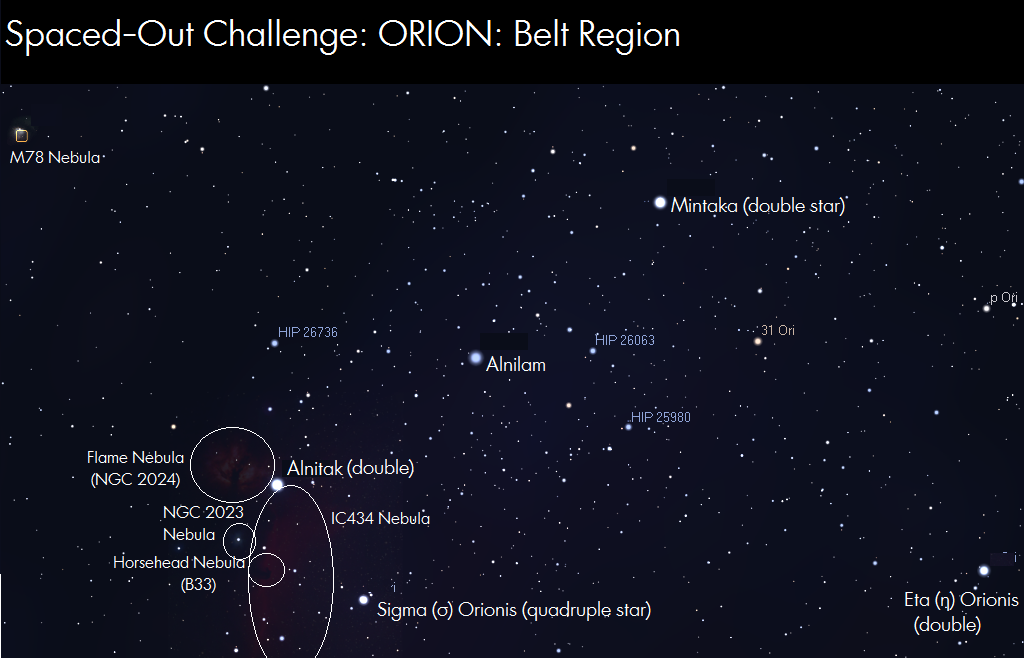
The belt region itself contains a loose cluster of stars that makes for a wondrous sight in binoculars. But most astrophotographers and determined visual observers focus on one region of the belt in particular: the environs of Alnitak.
Nebula, Nebula, and More Nebula Around Alnitak

The brightness of Alnitak is a boon and a pain for visual observers: a boon because it serves as a great starting point for locating dim but exciting nebulae, and a pain because it's light obscures these targets. I recommend keeping one eye eye-patched and dark-adapted as you start hunting these next treasures down, and use it only when you have moved the bright star out of view.
The Flame Nebula
NGC2024 is a bright emission nebula dimmed by it's proximity to Altinak. Center your eyepiece on Altinak, then edge your telescope westward. Crank your magnification up to around 100x to remove the star out of your view, insert a nebula filter behind your eyepiece (I recommend an O-III), and switch eyes. At first, you'll notice a U shaped mass with square edges, but as your dark-adapted eye relaxes and explores, you'll begin to notice the complexity around the edges, and the flames that give this nebula it's name. If you can't spot the nebula, don't bother proceeding to the next three, but if your sky is clear and steady and this mottled nebulosity is obvious, continue onwards.
NGC2023
The next nebula we will explore in this region is NGC2023. It's name isn't the most romantic, but the view on a crisp night with good optics certainly is: a mottled emission nebula just half-a-degree to the Flame's south. If you can catch it easily, then you have the perfect moment to attempt the holiest of holies for amateurs in Orion: spotting the Horsehead.
The Horsehead Nebula (B33) and IC 434
After you've enjoyed the Flame and eyeballed 2023, you're ready to try to spot the Horsehead. Made of the same structure as the famed Pillars of Creation, it is a dark nebula of cold gas whose shape is revealed by the brighter emission nebula IC434 behind it. IC434 stretches well over a degree south from Altinak, and is best revealed using a H-beta filter. After popping in the filter, which will greatly dim the far brighter stars, allow your eyes to adapt to the view in your eyepiece, crank the power up, and start tracing the length of the nebula. If the night is perfect, you'll notice a notch either directly or with averted vision- the Horsehead. The more aperture your scope has, the easier it is to see, but dark skies and a stable atmosphere are more important than carrying around a monster scope. For more tips on hunting it down, these three threads from CloudyNights outline the strategy and success of amateurs, some using equipment as small as an 80mm refractor.
More Doubles in the Belt
Eta Orionis: a rewarding challenge
With just 2" of seperation between the yellow primary and beautiful blue secondary, it can be a bit of a challenge to split in smaller telescopes, but the color difference is beautiful. Photographs like the above fail to really capture it: this is one for your eyes only. It is the brightest star between Mintaka and Rigel.
Sigma Orionis: Quite a Quadruplet
At least three of the four stars in this system are visible in small telescopes, and if you're armed with a moderate-sized dobsonian, all four pop into place. The brightest star in the system is itself a double, but one too close together to split, shining white. A fainter bluer star, a closer, fainter reddish one, and another fainter white one round the system out. A beautiful target when the moon makes nebula observing impossible.
M78, the "Headlights in Fog" Nebula

When you have astrophoto eye candy like the Horsehead, and the visual blowout that is the Great Nebula, it's easy to ignore M78, a bright emission nebula that is beautiful in it's own right. Finding M78 is a bit tricky not due to a lack of brightness but it's size:much smaller than the nebula complex around Alnitak and a mere fraction of M42. I found the best way to catch this small wonder is to start at Eta Orionis, and trace a line through Alnilam onto the nebula. Alnilam is almost exactly halfway between M78 and Eta. For those living in more urban zones, start at the bright star Alnitak, and drift just a few degrees to the north at low power, looking for two stars with a fuzzy appearance. At higher power, the nebula resembles a pair of headlights in fog, and in larger aperture telescopes, a second reflection nebula appears nearby.
Odds and Ends
Meissa
A beautiful double star marks the brightest of a cluster indicating Orion's head. The double makes for a great telescope target, the cluster a great binocular one, and the region as a whole has recently gotten the attention of amateurs. In the Head to Toes photo, do you notice the round puffy red cloud of nebulosity surrounding Meissa? Turns out it is actually visible (minus the color) from a dark sky site!
Grab your H-beta filter, and hold it up to your eye as you gaze at Meissa. Depending on the quality of the sky when observing, you will pick up anything from a faint halo of gas to a more nebulous ovoid as you wander back and forth across the head. A caveat: a light-pollution-free sky is a requirement to pull this off.
w Orionis: a carbon star

Return to the large map of Orion. Using it as a guide, arc through the various Pi stars in his shield, all the way down to faint Pi 6. Slightly more than the same distance between Pi 5 and Pi 6 down and away from Pi 6 lies w Orionis, a variable carbon star with an impressive rust color. From dark skies, a simple pair of binoculars reveals the color, but if it is at it's dimmest point, a telescope will be required.
Bernard's Loop
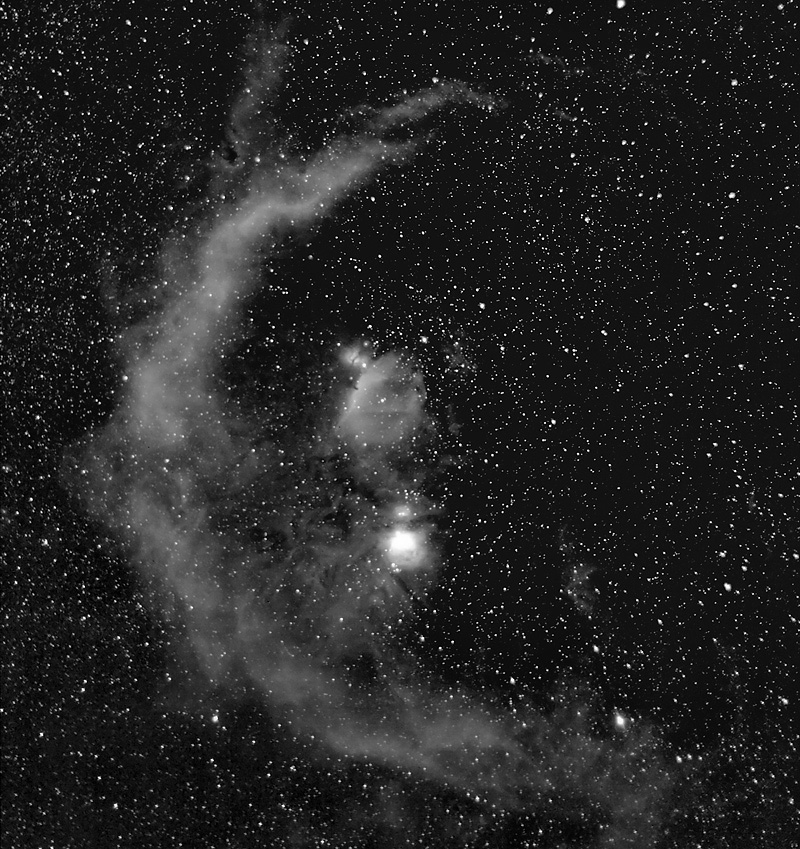
The largest feature of Orion is arguably the hardest to see visually- unless you have an H-beta filter. Bernard's Loop takes it's name from its astrophotographer discoverer E. E. Barnard, who discovered it in 1894. This massive expanse of ionized gas is believed to have origniated in a supernova explosion just two million years ago.
Due northeast of Alnitak is the reflection nebula M78 discussed earlier. But just a fraction of a degree away from it lies the faint open cluster NGC 2112. Look for this loose collection of stars in binoculars, then use the same trick applied for teasing out the Meissa nebulosity, holding the filter to your eye. the brightest part of the loop is closest to the open cluster.
A wide-field eyepiece at low power, filter applied, also reveals some of this massive structure. Amateurs have claimed to race nearly the entirety of the loop once thought only visible in photographs. Ty it out yourself, and see if you can claim the same.
Rigel
The brightest star in Orion, Rigel is actually a very close double- the super bright primary star shines blue, while a much fainter, white companion shines closeby. The tightness is so great the secondary often gets drowned out in the diffraction spikes emanating from Rigel in many dobsonians, but it is a rewarding and beautiful challenge nevertheless.
The Main Event: Orion's Sword
The brightest nebula in the northern sky, and it's progeny, form Orion's bright sword. While everything we have discussed thus far has been great for visual observers, this small patch of sky is the heart of the constellation. Ranging from the easy to the challenging, the objects within will keep you hunting and exploring until your hands are frozen solid these long winter nights.

NGC 1981: the "M" Cluster
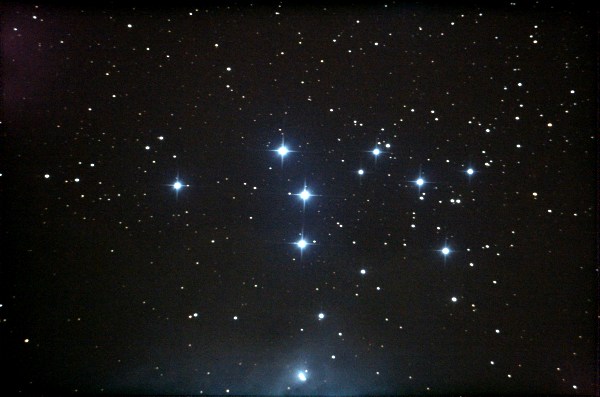
Near the top of the sword is the small but bright M shaped cluster NGC 1981. Best viewed in binoculars or a telescope at low power, these are some of the youngest to have left the greater Orion Molecular Cloud Complex.
The Running Man Nebula (NGC 1973,1975,1977)
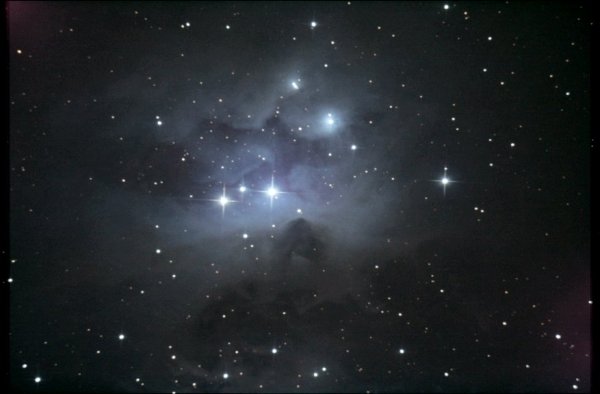
Actually three separate nebulae and a small star cluster, in low-power and with an O-III filter, the excitement really begins in the sword with the Running Man. Darker skies enhance the view and reveal the namesake.
DeMarian's Nebula (M43)
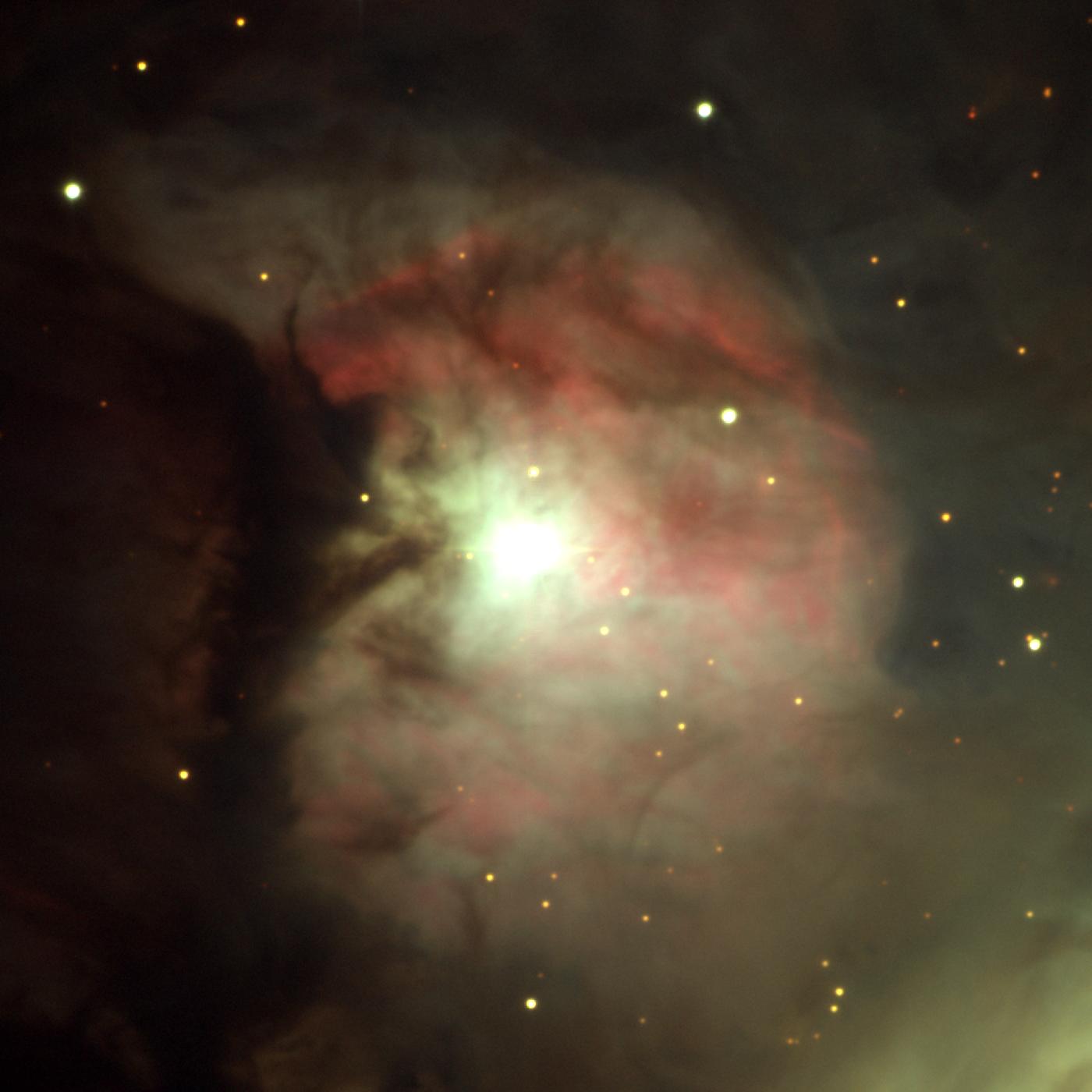
Separated from the main Great Nebula by a darkened mass of Hydrogen, DeMarian's is a region of excitement in it's own right: star formation has been observed within in as close to real time as astronomy could allow. Use an O-III or UHC filter to bring out the finer details within.
NGC 1980, Na'ir al Saif & Struve 747

A smaller region of nebulosity due south of the Great Nebula, NGC 1980 is partially illuminated by several bright double stars embedded within: Na'ir al Saif, the brightest star in the sword, is actually a colorful triplet, featuring a bright blue primary star and two slightly dimmer white ones. Struve 747 is a fainter but wider double to it's east. An O-III filter helps to bring out the nebulosity in more light-polluted areas.
NGC 1999, the V380 Nebula
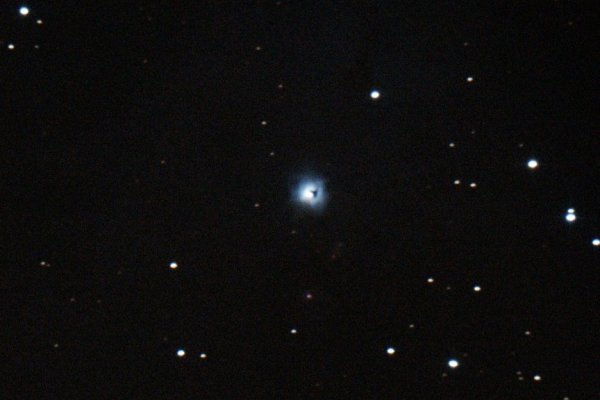
NGC1999 is a reflection nebula illuminated by variable star V380. The beautiful Bok Globule that marks the nebula with it's distinctive keyhole requires dark skies to see and cranking your magnification up to 11 (past 250x will begin to hint it, 300x and the shape becomes obvious). Look for a fuzzy 10th magnitude star south of NGC 1980, and crank it up from there.
The Greatest Nebula: M42
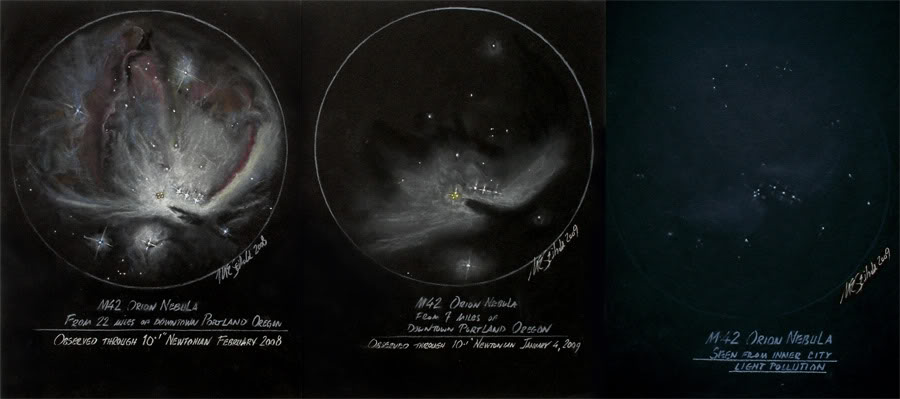
The Great Nebula in Orion has been photographed more than any other deep sky object, and it's not hard to see why: bright, expansive, and colorful, it has been observed for over four hundred years yet reveals surprises at a constant pace. The beautiful Trapezium stars, which illuminate much of the nebula, are found at it's heart. This quadruplet actually has two fainter members that can be picked out with larger telescopes, and was first documented by Galileo. At only 100,000 years old, these stars are some of the youngest objects we can spot in the sky. Theta 2 is a nearby double that also helps to illuminate the billowy cloud. The nebula is impressive from even the worst sky, and leaves you at a loss of words from a dark one. Color is absolutely visible with adapted eyes from a dark site. I've noticed traces of purple, blue and green through my 8" XT8.
The full Beginner's Buyer's Guide, our Comet Guide (featuring additional grab-and-go telescopes), and any other edition you're looking for can be found in the master index of all Spaced-Out Challenge threads here, but of course you can always inquire about binoculars, telescopes, and all the rest in the comments. As always, if you have astrophotography, product recommendations, or astronomy news you'd like to see on a future Spaced-Out Challenge, email me at theoneandonlyfinn (at) gmail.com, or tweet me @conartcritic.
Until next week, clear skies to you, and keep looking up!
Rev. Wishbone: ">>>All this spring talk has me recoiling. Posted ..."
Boss Moss: "Pepperonis? Tell me those aren't carrots. ..."
cmeat: "a number of music vids by avalanches are great. a ..."
FenelonSpoke: "Football thing are the top with crackers is fun. ..."
Boss Moss: "🥒 ..."
tubal: "Willowed last thread, but Food Thread, so apropo - ..."
Aetius451AD Johnson's work phone: "Horde perfection from end of last thread: Like ..."
WNBA: "What are we, chopped liver? ..."
Skip : "Having Cheesesteak tonight, nothing much to do wi ..."
Boss Moss: "That's a shame. A stainless steel spring doesn't c ..."
Anonymous Rogue in Kalifornistan (ARiK): "I called nude....(nood) ..."
First World Problems...
Iran And Minneapolis...They Are Nothing Alike!
Sunday Morning Book Thread - 1-11-2026 ["Perfessor" Squirrel]
Daily Tech News 11 January 2026
Saturday Night Club ONT - January 10, 2026 [Double Ds]
Music Thread: Dipping Into The Archives Edition
Hobby Thread - January 10, 2026 [TRex]
Ace of Spades Pet Thread, January 10
Gardening, Home and Nature Thread, Jan 10
Paul Anka Haiku Contest Announcement
Integrity SAT's: Entrance Exam for Paul Anka's Band
AllahPundit's Paul Anka 45's Collection
AnkaPundit: Paul Anka Takes Over the Site for a Weekend (Continues through to Monday's postings)
George Bush Slices Don Rumsfeld Like an F*ckin' Hammer
Democratic Forays into Erotica
New Shows On Gore's DNC/MTV Network
Nicknames for Potatoes, By People Who Really Hate Potatoes
Star Wars Euphemisms for Self-Abuse
Signs You're at an Iraqi "Wedding Party"
Signs Your Clown Has Gone Bad
Signs That You, Geroge Michael, Should Probably Just Give It Up
Signs of Hip-Hop Influence on John Kerry
NYT Headlines Spinning Bush's Jobs Boom
Things People Are More Likely to Say Than "Did You Hear What Al Franken Said Yesterday?"
Signs that Paul Krugman Has Lost His Frickin' Mind
All-Time Best NBA Players, According to Senator Robert Byrd
Other Bad Things About the Jews, According to the Koran
Signs That David Letterman Just Doesn't Care Anymore
Examples of Bob Kerrey's Insufferable Racial Jackassery
Signs Andy Rooney Is Going Senile
Other Judgments Dick Clarke Made About Condi Rice Based on Her Appearance
Collective Names for Groups of People
John Kerry's Other Vietnam Super-Pets
Cool Things About the XM8 Assault Rifle
Media-Approved Facts About the Democrat Spy
Changes to Make Christianity More "Inclusive"
Secret John Kerry Senatorial Accomplishments
John Edwards Campaign Excuses
John Kerry Pick-Up Lines
Changes Liberal Senator George Michell Will Make at Disney
Torments in Dog-Hell
The Ace of Spades HQ Sex-for-Money Skankathon
A D&D Guide to the Democratic Candidates
Margaret Cho: Just Not Funny
More Margaret Cho Abuse
Margaret Cho: Still Not Funny
Iraqi Prisoner Claims He Was Raped... By Woman
Wonkette Announces "Morning Zoo" Format
John Kerry's "Plan" Causes Surrender of Moqtada al-Sadr's Militia
World Muslim Leaders Apologize for Nick Berg's Beheading
Michael Moore Goes on Lunchtime Manhattan Death-Spree
Milestone: Oliver Willis Posts 400th "Fake News Article" Referencing Britney Spears
Liberal Economists Rue a "New Decade of Greed"
Artificial Insouciance: Maureen Dowd's Word Processor Revolts Against Her Numbing Imbecility
Intelligence Officials Eye Blogs for Tips
They Done Found Us Out, Cletus: Intrepid Internet Detective Figures Out Our Master Plan
Shock: Josh Marshall Almost Mentions Sarin Discovery in Iraq
Leather-Clad Biker Freaks Terrorize Australian Town
When Clinton Was President, Torture Was Cool
What Wonkette Means When She Explains What Tina Brown Means
Wonkette's Stand-Up Act
Wankette HQ Gay-Rumors Du Jour
Here's What's Bugging Me: Goose and Slider
My Own Micah Wright Style Confession of Dishonesty
Outraged "Conservatives" React to the FMA
An On-Line Impression of Dennis Miller Having Sex with a Kodiak Bear
The Story the Rightwing Media Refuses to Report!
Our Lunch with David "Glengarry Glen Ross" Mamet
The House of Love: Paul Krugman
A Michael Moore Mystery (TM)
The Dowd-O-Matic!
Liberal Consistency and Other Myths
Kepler's Laws of Liberal Media Bias
John Kerry-- The Splunge! Candidate
"Divisive" Politics & "Attacks on Patriotism" (very long)
The Donkey ("The Raven" parody)

